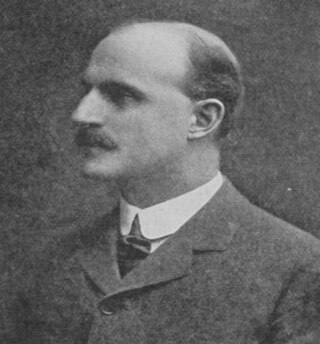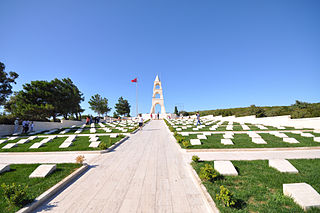
The Dardanelles, also known as the Strait of Gallipoli and in Classical Antiquity as the Hellespont, is a narrow, natural strait and internationally significant waterway in northwestern Turkey that forms part of the continental boundary between Asia and Europe and separates Asian Turkey from European Turkey. Together with the Bosporus, the Dardanelles forms the Turkish Straits.

The Gallipoli peninsula is located in the southern part of East Thrace, the European part of Turkey, with the Aegean Sea to the west and the Dardanelles strait to the east.

The Gallipoli campaign, the Dardanelles campaign, the Defense of Gallipoli or the Battle of Gallipoli was a military campaign in the First World War on the Gallipoli peninsula from 19 February 1915 to 9 January 1916. The Entente powers, Britain, France and the Russian Empire, sought to weaken the Ottoman Empire, one of the Central Powers, by taking control of the Ottoman straits. This would expose the Ottoman capital at Constantinople to bombardment by Entente battleships and cut it off from the Asian part of the empire. With the Ottoman Empire defeated, the Suez Canal would be safe and the Bosphorus and Dardanelles straits would be open to Entente supplies to the Black Sea and warm-water ports in Russia.

The First Battle of Krithia was the first Allied attempt to advance in the Battle of Gallipoli during the First World War. Starting on 28 April, three days after the Landing at Cape Helles, the defensive power of the Ottoman forces quickly overwhelmed the attack, which suffered from poor leadership and planning, lack of communications, and exhaustion & demoralisation of the troops.

HMS Majestic was a Majestic-class pre-dreadnought battleship of the Royal Navy. Commissioned in 1895, she was the largest pre-dreadnought launched at the time. She served with the Channel Fleet until 1904, following which she was assigned to the Atlantic Fleet. In 1907, she was part of the Home Fleet, firstly assigned to the Nore Division and then with the Devonport Division. From 1912, she was part of the 7th Battle Squadron.

Lieutenant Colonel Charles Hotham Montagu "Richard" Doughty-Wylie, was a British Army officer and an English recipient of the Victoria Cross, the highest award for gallantry in the face of the enemy that can be awarded to members of the British and Commonwealth armed forces. Doughty-Wylie had been awarded the Order of the Medjidie from the very Ottoman Government he later fought against. He was generally known as Richard.

Suvla is a bay on the Aegean coast of the Gallipoli peninsula in European Turkey, south of the Gulf of Saros.

Quinn's Post Cemetery is a Commonwealth War Graves Commission cemetery from World War I in the former Anzac sector of the Gallipoli Peninsula, Turkey. The battles at Gallipoli, some of whose participating soldiers are buried at this cemetery, were an eight-month campaign fought by Commonwealth and French forces against Turkish forces in an attempt to force Turkey out of the war, to relieve the deadlock of the Western Front (France/Belgium) and to open a supply route to Russia through the Dardanelles and the Black Sea.
Achi Baba is a height dominating the Gallipoli Peninsula in Turkey, located in Çanakkale Province. Achi Baba was the main position of the Ottoman Turkish defenses in 1915 during the World War I Gallipoli campaign. Mediterranean Expeditionary Force Commander-in-Chief Sir Ian Hamilton had set the capture of Achi Baba as a stated priority for operations during the Allied landing at Cape Helles on 25 April 1915. Four separate attempts were made by the Allies to seize Achi Baba and the village of Krithia between April and July, but the heights remained in Turkish hands for the duration of the campaign.
Hill 10 Cemetery is a Commonwealth War Graves Commission Cemetery in the former Suvla Bay sector of the Gallipoli Peninsula, Turkey. The battles at Gallipoli, some of whose participating soldiers are buried at this cemetery, was an eight-month campaign fought by Commonwealth and French forces against Turkish forces in an attempt to force Turkey out of the war, to relieve the deadlock of the Western Front (France/Belgium) and to open a supply route to Russia through the Dardanelles and the Black Sea.

Hill 60 Cemetery is a Commonwealth War Graves Commission cemetery dating from World War I at the Northern end of the former Anzac sector of the Gallipoli Peninsula, Turkey and the location of Hill 60 Memorial, one of four memorials on the peninsula which commemorate New Zealanders killed in the campaign but who have no known grave.

Johnston's Jolly Cemetery is a Commonwealth War Graves Commission cemetery containing the remains of some of the Allied troops who died during the Battle of Gallipoli.

New Zealand No. 2 Outpost Cemetery is a small Commonwealth War Graves Commission cemetery containing the remains of some of the Allied troops who died during the Battle of Gallipoli.

Courtney's and Steel's Post Cemetery is a Commonwealth War Graves Commission cemetery located near ANZAC Cove on the Gallipoli peninsula in Turkey. It contains the graves of some of the former British Empire troops who died during the Gallipoli Campaign.

The 57th Infantry Regiment Memorial is a Turkish war memorial commemorating the men of the Ottoman 57th Infantry Regiment who died during the Gallipoli campaign.

Lone Pine Cemetery is a Commonwealth War Graves Commission cemetery dating from World War I in the former Anzac sector of the Gallipoli Peninsula, Turkey and the location of the Lone Pine Memorial, one of five memorials on the peninsula which commemorate servicemen of the former British Empire killed in the campaign but who have no known grave.

Morto Bay is an inlet on the South West tip of Cape Helles on the Gallipoli Peninsula in Turkey. The bay is in the north west (European) coast of the Dardanelles strait, which connects the Sea of Marmara to Aegean Sea. The Gallipoli Peninsula is to the north of the bay. Administratively it is a part of Çanakkale Province. The width of the bay is about 2.6 kilometres (1.6 mi) The name of the bay is probably of Italian origin.

The Helles Memorial is a Commonwealth War Graves Commission war memorial near Sedd el Bahr, in Turkey, on the headland at the tip of the Gallipoli peninsula overlooking the Dardanelles. It includes an obelisk which is over 30 metres (98 ft) high.

The Battle of Kumkale was a World War I battle fought between Ottoman and French forces. It was a part of the Gallipoli Campaign fought on the Anatolian (Asian) part of the Dardanelles Strait as a diversion from the main landings on the Gallipoli peninsula. Kumkale is the name of a village which now is a part of Troy national park.

















